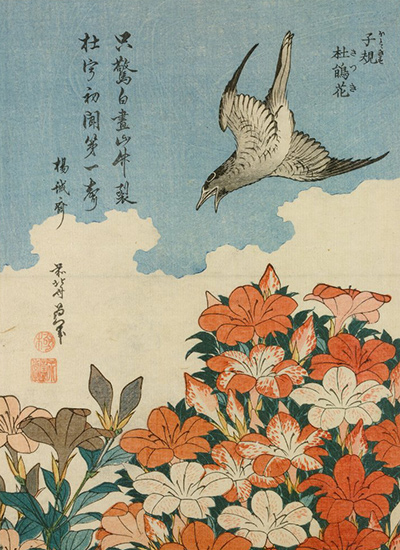Hokusai
Cuckoo and Azaleas by Hokusai
Cuckoo and Azaleas, known in Japanese as Hototogisu satsuki, is a woodblock print by Katsushika Hokusai. The print, depicting a garden of orange azaleas and a lesser cuckoo in flight, was created around 1828, with further prints produced in 1834. It is typical of Hokusai’s woodblock and paper works, featuring natural scenes. Cuckoo and Azaleas measures 25.4 cm by 18.6 cm.
Cuckoo and Azaleas is an example of the Japanese ukiyo-e style, popular in the 17th, 18th and 19th centuries. Artworks including woodblock prints and paintings depicted natural landscapes as well as scenes from Japanese history and culture. In this technique, images were pressed onto paper by hand using woodblocks. Cucko and Azaleas is also a prime example of Kachoga, or “bird and flower paintings”, in Hokusai’s work. This is a genre stretching throughout Chinese and Japanese artwork. Cuckoo and Azaleas is part of Hokusai’s Small Flowers series.
This work is noted for its Japanese inscription covering the left side of the print. The quotation comes from a poem by noted Southern Song dynasty poet, Yang Wanli. Translated into English, the inscription reads: “A single cuckoo by day splits the mountain bamboo / with an initial cry upon first hearing about Du Yu.” This refers to the death of Chinese general Du Yu. The call of a cuckoo was said to be heard upon his death, according to legend.
Cuckoo and Azaleas is noted for its use of the colour orange, as well as Prussian blue for the sky background. Illustrations of a similar lesser cuckoo can be noted in Hokusai’s Santai gafu collection from 1816. This work as been cited as an example of the themes of “power and serenity in Japanese nature prints”, according to the Rhode Island School of Design Museum. Prints of Cuckoo and Azaleas are on display in several museum collections around the world, including the Guimet Museum in Paris, France and the British Museum in London, England.
